What is Pipedrive CRM? Do You Need a Pipeline CRM?
Updated on 25th Sept, 2024.
In the fast-paced world of sales and client relationship building, you will need some fantastic technology to support your daily needs. Thankfully, services such as Pipedrive CRM exist to help you manage your customer relationship with efficiency and care. But what exactly does Pipedrive do? What even is a CRM as a concept?
If you’re looking for ways to build new client relationships and serve customers, it’s time to consider a leading CRM. However, as always, it pays to do a little homework before you leap into any particular brand. Let’s take a closer look at the concept.
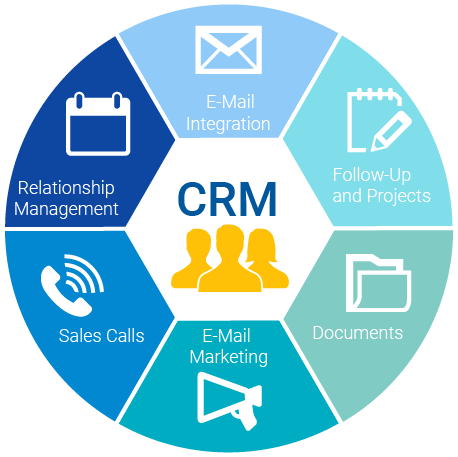
Source: perfectviewcrm.com
What is a CRM?
CRM stands for Customer Relationship Management. A CRM platform acts as a central hub where you can manage multiple accounts and projects.
A CRM helps you track customers, know where they are in the sales process and move them through a systematic sales process. Crucially, it may also be a useful space for you to ensure your team members are all on the same page.
Modern businesses require careful streamlining. That applies to all departments. Companies use CRMs to gain useful insights into current project progress, as well as what they are doing to reach out to customers.
Why is a CRM Needed? How Does it Help Sales?
Effective sales strategies, naturally, revolve around building relationships, not just acquiring leads. A CRM is the perfect asset in helping sales manage their clients. It offers customers and clients peace of mind and confidence, too, that a business is constantly in-touch through the service stages.
For salespeople, a CRM is a fantastic asset in helping to follow up on leads. A CRM platform will allow you to monitor client records, to keep track of multiple conversations, and to process follow-ups. A good CRM will allow sales teams to follow up with prospects through a simple UI quickly. This, of course, will also be beneficial to everyday clients and customers.
A sales CRM is a measure of productivity and success. All your sales data is collated in one place, and it is simple to trace the history of conversations. This way, sales professionals can continue to ensure they are on-message with their brand and on-target with their prospects.
Crucially, the best CRMs will allow sales teams to refine and target their sales strategies carefully. There is no need for guesswork. All parties in the sales chain will be kept up to speed on what is happening. What’s more, it is likely to save you time and money in streamlining the whole process.
What is a Pipeline CRM?
There are different types of CRM services available. A pipeline CRM, for example, is one that carefully maps out each stage of your sales pipeline. That may be obvious from the name of the service alone. However, it is how these CRMs manage your sales pipelines.
A pipeline CRM helps you create different stages of the sales process and move leads through each stage. You’ll receive useful notifications and reminders of what you need to do at each stage of the process.
Therefore, it is a system that is specifically designed for sales processes. As sales pipelines will differ from company to company – and from prospect to prospect – the best tools will be flexible, versatile, and endlessly manageable to your own needs.
The whole aim of a pipeline CRM is to keep your clients engaged. It’s a system where you can ensure your leads don’t stick or drop off at the second or third rung of the pipe. Essentially, it’s a useful organizer that you can fall back on if things start to get a little murky or hard to follow.
How Does a Pipeline CRM Work Differently From Other CRMs?
Pipeline CRMs are built explicitly for sales analysis, lead nurturing, and pipeline follow-ups. These systems benefit from the same assets a standard CRM will offer. Therefore, it will always be easy for you and your team to follow each stage of the lead building process. What’s more, there will always be opportunities for you to collaborate, communicate, and ensure everyone is on the same page.
However, the main difference between a pipeline CRM and other types of CRM is the fact that the pipeline takes center stage. A pipeline system will clearly lay out and annotate user-defined stages of the sales process. You will be able to set up reminders, triggers, and useful tools to tie in with each stage of the sales pipeline.
A CRM offering pipeline analysis as its main feature is going to be organized a little differently. Collaboration-focused CRMs, for example, will offer more emphasis on file-sharing and online workspaces. Pipeline services, meanwhile, will divide workflows up into the stages you expect. This is beneficial to both the sales team and the client. This way, everyone is up to date and up to speed on where things are heading.
Benefits of Using a Pipeline CRM
The creation of a sales funnel is merely the beginning. It wouldn’t be as effective without proactive management. To make the most of your resources, think about optimising your pipelines.
Sales teams have a better understanding of the quantity and calibre of leads they must move through each stage of the sale thanks to pipeline management. In addition to this, the following five advantages come from efficiently managing your pipeline:
Improved lead and sales process management
Pipeline CRMs visualize the sales funnel, enable lead tracking, prioritization, and automation, which in turn, improves lead and sales process management. It facilitates data-driven decisions for more effective lead conversion and sales processes by centralising data, providing analytics, and supporting forecasts. This improves communication and scalability.
Elevated sales productivity
With pipeline CRM’s sales pipeline management capabilities, you can quickly track your sales team’s progress and identify any areas of difficulty. The team managers can then strengthen the team members’ efforts and assist them where they are weak. This may help increase the overall productivity of the sales team. Goal-tracking also inspires sales teams, and scalability guarantees productivity, as your company grows.
Streamlined communication between stakeholders
Pipeline CRMs simplify stakeholder communication by gathering all relevant customer data on a single platform. To ensure smooth cooperation, sales teams can write notes, exchange updates, and access historical data about leads and clients. Team members are kept up to date on significant changes thanks to notifications and alerts, preventing information gaps or delays.
Additionally, pipeline CRMs often tend to integrate with email and messaging apps, allowing for direct collaboration from the CRM interface. This centralized hub for communication encourages openness, lessens misunderstandings, and enables more coordinated and effective efforts among sales, marketing, and other departments involved in the sales process, ultimately improving customer relationships and sales outcomes.
Enhanced funnel visibility and sales forecasting
Pipeline CRMs enhance funnel visibility by providing granular insights into the sales process. Teams may follow a lead’s development through each stage in this way, making it simpler to spot bottlenecks or problem areas. These CRMs provide information on conversion rates, average transaction values, and sales cycle length using historical data and analytics tools.
Customer data enables precise sales forecasting, that assists businesses in setting sensible objectives and efficiently allocating resources. These CRMs enable proactive decision-making, prompt modifications, and more accurate predictions by providing a clear view of the complete sales pipeline, thus enhancing sales performance and revenue estimates.
Scalability through proper resource allocation
Making the most of each sales stage also enables sales managers to decide how much and what resources are required to advance a contract to the following stage. For instance, a company can coordinate the efforts of its marketing and sales departments. Pipeline management can promote synergy between the two rather than considering them as competitors, freeing up more resources and energy for use elsewhere.
Pipeline CRMs can also assist businesses in calculating the pace at which every individual sales representative can turn a prospect into a deal. When planning campaigns and predicting results, it is helpful to know the typical conversion time for your customers. These figures will also enable you to determine whether your staff is effective at turning interested leads into paying customers.
Now that you have an understanding of CRMs that enable pipeline management, let’s discuss Pipedrive CRM—one of the most popular CRM platforms for salespeople across the world.
Introduction to Pipedrive CRM
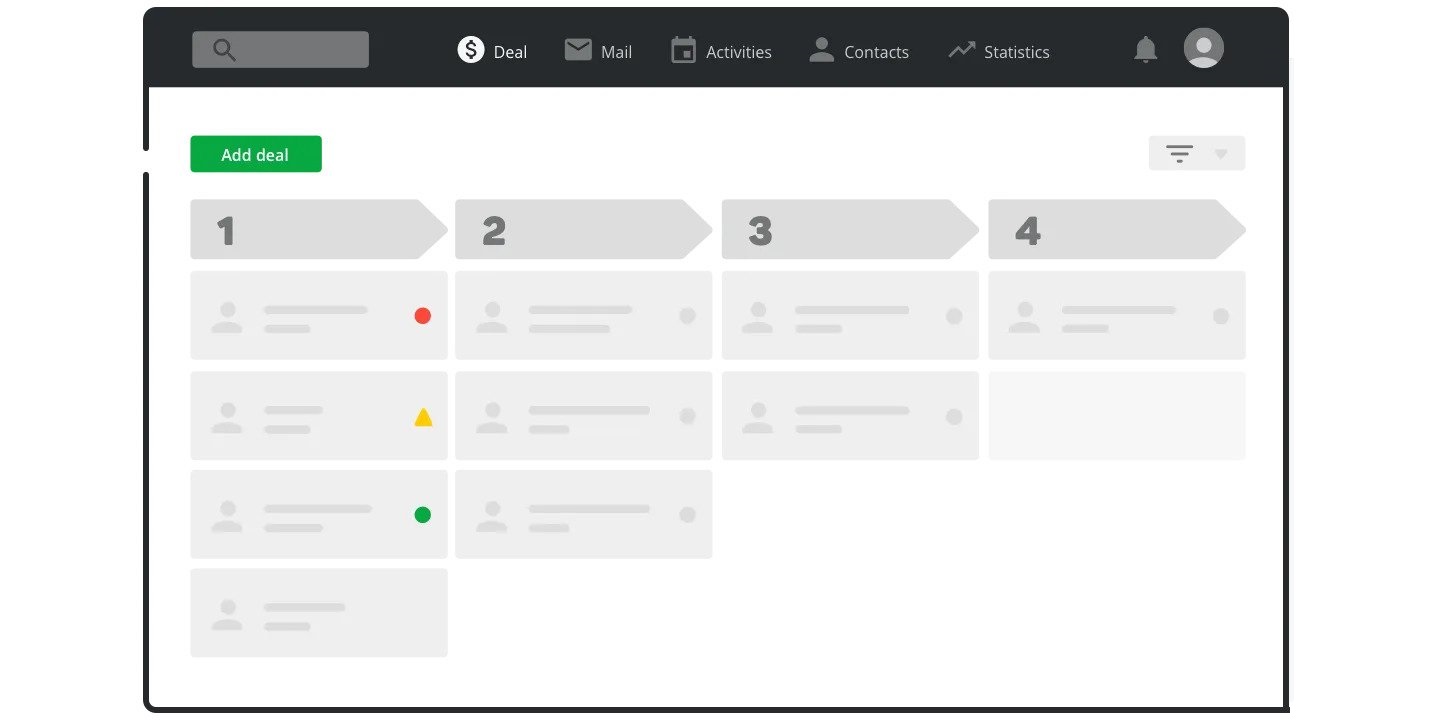
Pipedrive CRM is a leading pipeline CRM service that seeks to make the sales and relationship-building process more efficient than ever. Pipedrive helps you easily import your leads, assign them to your salespeople and move them through different stages of the sales cycle. With Salespanel integration, it can enrich all records with marketing data and provide crucial sales intelligence.
Pipedrive is entirely customizable. That means that you can establish your own unique sales processes and patterns without having to fall back on any default standards. One of the significant driving benefits of using Pipedrive lies in its incredible flexibility.
Pipedrive exists not only to remind and report users on stages in the pipeline but to cleanly correlate it with data. Many sales experts will head to Pipedrive with clusters of spreadsheets and confusing data patterns and turn them into usable info.
Ultimately, Pipedrive strives to help keep your sales drivers and processes running in a clear order. Some Pipedrive CRM alternatives can help with marketing automation and customer support, or project management and AI-based live chat.nd long-term targets. Pipedrive, meanwhile, is perfect for managing sales from end to end.
Features of Pipedrive CRM
Pipedrive boasts a number of great features that sales teams are likely to find useful:
1. Customization
Contrary to the majority of CRMs, Pipedrive lets you customize the platform to meet your needs. For instance, users can build up automations that support your business and customisation rules, and they can customise data fields to meet their specific needs. You must remember that you’ll need a developer to take full advantage of the adjustments made to the API and webhooks because they can streamline the team’s work.
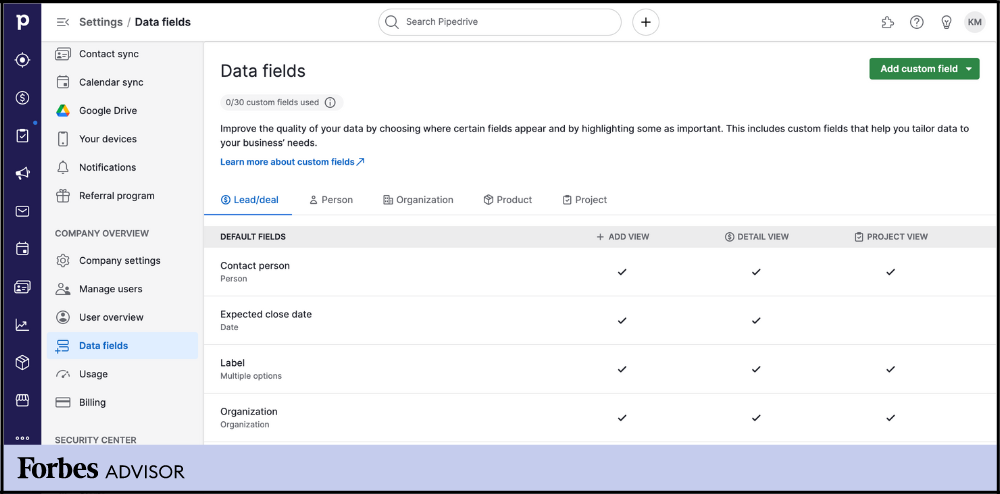
Source: Forbes Advisor
2. Chatbots
Pipedrive offers a customizable chatbot feature that businesses businesses may put on their website to collect fresh leads that are added automatically to the sales funnel. This introduces a crucial method for businesses to obtain warm and hot leads that don’t slip through the gaps while customers browse the internet.
The setup procedure is fairly easy to understand and carry out. Pipedrive, however, does a poor job of making it simple to find. From your account dashboard, you need to select leads (the first icon on the left-hand vertical menu) for assistance. You can then look for the “Leadbooster” area and click “Chatbot.” This will prompt the creation of a new chatbot.

Source: Forbes Advisor
3. Ease of Use
The Pipedrive CRM platform is a simple sales programme that can be mastered without extensive training. With a simple interface, it doesn’t overwhelm consumers with information when giving them a broad overview of leads. The salesrep has less paperwork to complete because the platform uses AI to guide you through the process, allowing them to spend more time interacting with prospects and closing deals.
4. Workflows and Automations
With Pipedrive CRM, you can focus on leads as works best for your process. You can also track leads according to where they are in the sales funnel by starting with a lead board in the Kanban style. You may also look at the lead in a list that classifies leads according to their propensity to purchase and records the latest activity date. This makes it more likely that leads will be handled promptly and that none will slip through the cracks. You have access to all notes and communications for the leads you choose to focus on, so you always know what is happening and where the prospects are at.
5. Third-Party Integrations
As a fully functioning CRM, Pipedrive integrates with popular third-party marketing, sales, customer success, analytics and 400+ different applications such as Zapier, HubSpot, Zoom, Google Analytics, etc.
Besides these, here are some additional features that make Pipedrive one of the most popular CRMs for salespeople worldwide:
- Build, label and manage your own custom pipelines and process stages
- Track your complete contact history from start to end
- Pull leads from chatbots and email forms and through integrations (eg: Salespanel)
- Track communications and have full visibility
- Get complete control over your business data and sales paths
- Automate tasks with Pipedrive and its integrations
- Automate lead sourcing and build relationships
Crucially, Pipedrive provides the above features and more with efficiency, thanks to a user-friendly UI. You can learn more from here.
Pipedrive as a Pipeline CRM – How Does it Differ From Others in the Market?
Pipedrive competes against other specialist pipeline CRMs with a variety of exclusive features and cost-effective plans. Here are just a few positive reasons for why the platform sits apart from the competition:
- Pipedrive is a really easy to use pipeline CRM
- The service integrates with over 350 third party programs, platforms, and services
- Pipedrive offers a variety of apps, across Android, iOS and via web
- Pipedrive remains one of the most customizable CRMs available
- Unlike some CRMs and platforms, Pipedrive is built to scale and grow with your business
- The platform is easy to use and requires minimal training to adapt to
- Data such as spreadsheets are always straightforward to import and export
- Full client support is available through a helpline, email, and live chat
- The same support channels are available to your customers
How Much Does Pipedrive Cost?
Pricing for the Pipedrive platform is flexible and cost-effective. The system is currently available to new users at the following levels:
Essential – US $12.50 per month, per user, with access to entry-level pipeline management
Advanced – US $24.90 per month, per user, with access to intermediate automation and workflow management
Professional – US $49.90 per month, per user, with complete access to Pipedrive’s best CRM facilities
Enterprise – US $99.90 per month, per user, built for bigger businesses for wider onboarding
Pipeline-focused CRM Alternatives for Pipedrive
Salesmate
Salesmate is a strong alternative to Pipedrive for businesses seeking more advanced built-in communication features. Like Pipedrive, it offers a pipeline management solution, but it also includes powerful automation features such as follow-up emails. To achieve similar functionality in Pipedrive, one would need to use third-party integrations.
Salesmate also has built-in calling, SMS, and video conferencing, making it an excellent choice for businesses that prioritize multi-channel communication directly within the CRM.
Pipedrive’s entry-level pricing is more affordable, starting at $12 per user per month, while Salesmate’s pricing starts at $23 per user per month.
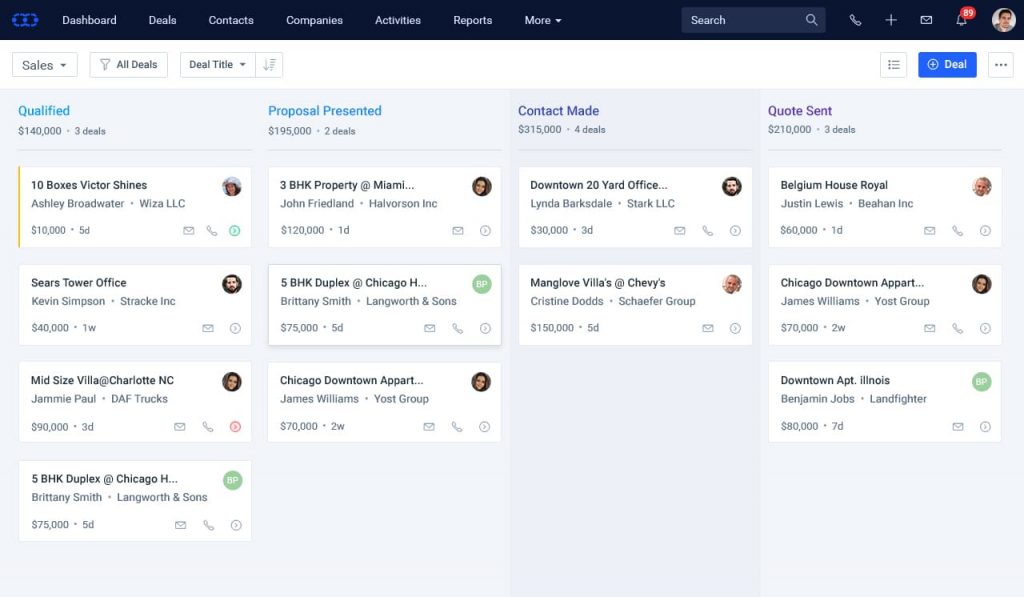
Close.io
Close.io is designed for sales-heavy environments, with its main strength lying in its communication tools, such as built-in calling, SMS, and email functionality, all tightly integrated into the platform. However, Close.io focuses more on list views rather than the visual pipeline experience that Pipedrive offers.
Close.io also provides lead scoring and sales automation features, which can be particularly useful for teams focused on personalized sales processes. To get lead scoring in Pipedrive, one would need to use an additional tool like Salespanel.
Close.io’s pricing starts at $59 per user per month, a significantly higher entry point compared to Pipedrive.
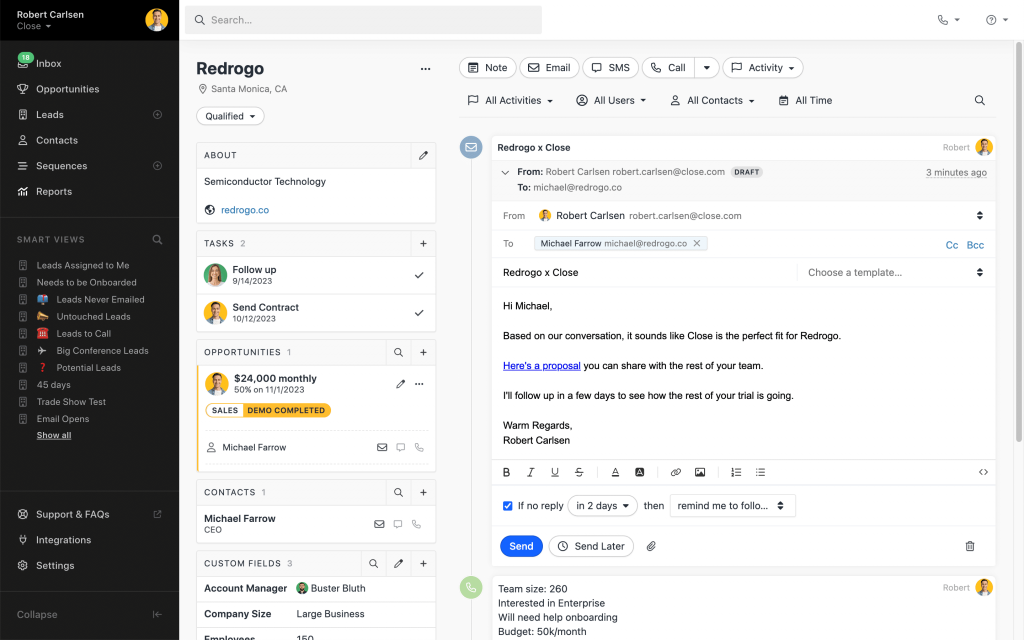
Final Thoughts
Maintaining a sales pipeline, historically, has been relatively complex. However, in the age of the flexible, user-friendly CRM, it’s getting easier to keep track of where your leads are heading. To build the best relationships, and to really drive revenue, clarity and confidence are key.
Pipedrive CRM will offer you full pipeline oversight. This will help you to manage your sales targets and to ensure your prospects are happy, confident, and well-informed. Why waste time using multiple programs and spreadsheets to confuse matters? Always choose a leading pipeline CRM which blends together complex, crucial data for long-term leads and financial success.
Sell more, understand your customers’ journey for free!
Sales and Marketing teams spend millions of dollars to bring visitors to your website. But do you track your customer’s journey? Do you know who buys and why?
Around 8% of your website traffic will sign up on your lead forms. What happens to the other 92% of your traffic? Can you identify your visiting accounts? Can you engage and retarget your qualified visitors even if they are not identified?



